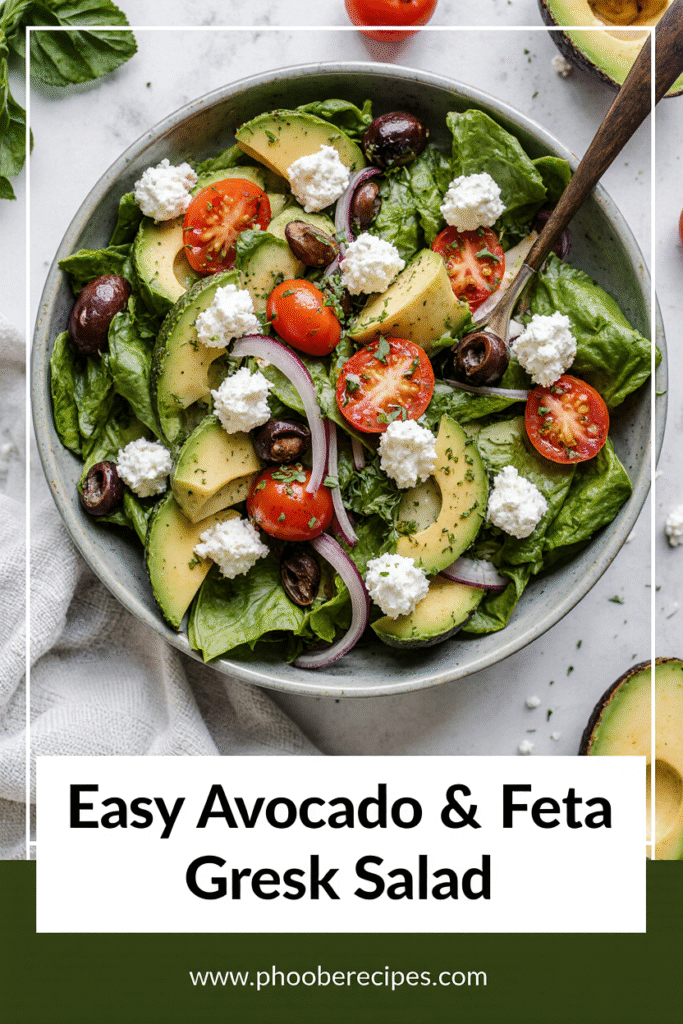How to Make the Best Greek Salad Recipe: Quick Summer Version with Avocado
Ready for a greek salad recipe that takes less than 10 minutes to prepare? This crunchy, vibrant summer dish has become my go-to for everything from lazy Sunday dinners to camping getaways and BBQ parties.
Because the vegetables are at their prime during summer months, this greek salad recipe easy to make and incredibly flavorful with just a few ingredients. Whether you’re looking for the perfect greek salad ingredients or wondering how to make greek salad with a modern twist, our avocado feta salad version truly celebrates the bounty of a summer vegetable garden. While a traditional Greek salad consists of cucumbers, tomatoes, bell peppers, red onion, olives, and feta cheese, adding avocado brings a creamy texture that transforms this classic into something special. This avocado greek salad pairs wonderfully with grilled meats, chicken, seafood, and pasta, making it versatile enough to serve as a side dish, appetizer, or even a light meatless and gluten-free meal.
In this article, I’ll share my favorite version of this Mediterranean classic that’s not only delicious but also packed with nutrients – each serving delivers 8g of fiber and is rich in healthy fats. Let’s dive into creating the perfect summer salad!
Essential Ingredients for a Greek Avocado Salad
The foundation of any remarkable greek salad recipe starts with selecting the right ingredients. Creating a perfect harmony of flavors requires attention to detail and quality components that complement each other.
Fresh vegetables to include
For an authentic avocado greek salad, start with ripe, juicy tomatoes. Roma tomatoes work wonderfully, though cherry tomatoes are excellent alternatives as they release less water into your salad and maintain their shape better. English cucumbers are ideal since their thinner skin doesn’t require peeling and they offer a milder, sweeter flavor. Green bell peppers add a crisp texture and are traditionally used in authentic recipes, although you can experiment with red or yellow varieties for a sweeter profile. Finally, thinly sliced red onion provides a sharp, tangy flavor that balances the richness of other ingredients – soaking slices in ice water with a dash of vinegar helps mellow their intensity.
Choosing the right feta cheese
Feta cheese is undoubtedly the centerpiece of any greek salad ingredients list. Look for blocks packed in brine rather than pre-crumbled options, as the brine preserves texture, enhances flavor, and extends shelf life for up to three months. True Greek feta, made from sheep’s milk or a combination of sheep’s and goat’s milk, delivers the most authentic tangy, salty flavor profile. Mt. Vikos is consistently rated by chefs as a top choice for its traditional taste and texture. Bulgarian feta tends to be saltier with a firm yet creamy texture, whereas French feta offers a milder, creamier experience. Regardless of origin, avoid pre-crumbled varieties which often contain anti-caking agents that can make the cheese taste dry and chalky.
Why avocado makes a difference
Adding avocado transforms a traditional greek salad into something extraordinary. Its creamy texture creates a beautiful contrast against the crunchy vegetables and complements the briny feta perfectly. Furthermore, avocado contributes healthy fats that enhance the salad’s nutritional profile. For best results, select a firm-ripe avocado and add it at the very end of preparation, gently coating pieces with dressing before mixing to prevent mushiness.
Optional add-ins for extra flavor
To customize your avocado feta salad, consider additional ingredients that enhance its Mediterranean character. Fresh herbs like flat-leaf parsley add brightness, though oregano remains the quintessential Greek herb. For protein, chickpeas or grilled shrimp integrate seamlessly. Artichoke hearts contribute tang and complexity, whereas kalamata olives deliver essential briny notes – always choose pitted ones for convenience. For an interesting twist, pepperoncini adds mild heat without overwhelming the delicate flavor balance.
How to Make the Best Greek Salad Dressing
The perfect dressing ties together all the fresh ingredients in your avocado greek salad, elevating the dish from simple to spectacular. A homemade Greek dressing takes just minutes to prepare yet delivers significantly more flavor than store-bought alternatives.
Classic ingredients for the dressing
At its core, Greek salad dressing combines olive oil, red wine vinegar, and seasonings. Most recipes include 6-7 essential components: high-quality extra-virgin olive oil, red wine vinegar, fresh garlic (or garlic powder), dried oregano, Dijon mustard, salt, and freshly ground black pepper. For authentic Greek flavor, the dried oregano is particularly important as it provides the distinctive aromatic notes associated with Mediterranean cuisine.
The process is remarkably simple:
- Whisk together the vinegar, mustard, salt, and seasonings in a small bowl
- Slowly stream in the olive oil while continuing to whisk until emulsified
- Taste and adjust seasonings as needed
Best vinegar options and swaps
Red wine vinegar is the traditional acid in Greek dressing, providing the signature tangy flavor. However, several modifications can customize your dressing:
- Replace some or all vinegar with fresh lemon juice for a brighter taste
- Use white wine vinegar for a milder flavor profile
- Add a small amount of balsamic vinegar for complexity
Essentially, the quality of your vinegar matters – a good red wine vinegar creates the foundation for an exceptional dressing.
Tips for balancing acidity and flavor
Initially, aim for a 3:1 ratio of oil to acid (vinegar/lemon juice) as your starting point. Subsequently, you can adjust to suit your preferences. If your dressing tastes too acidic or sharp, try:
- Adding a teaspoon of honey or sugar to mellow the tanginess
- Incorporating a bit more olive oil to soften the acidity
- Including 2-3 tablespoons of Greek yogurt for a creamy variation
The mustard in the recipe does more than add flavor – it helps emulsify the dressing, creating a cohesive mixture that clings beautifully to your salad ingredients instead of separating or pooling at the bottom of your bowl.
Step-by-Step: How to Make Greek Salad
Creating an exceptional greek salad recipe requires attention to detail in preparation and assembly. A few simple techniques will transform ordinary ingredients into an extraordinary dish that highlights each component perfectly.
Prepping and chopping ingredients
The size and uniformity of your vegetables matter tremendously in this dish. Dice tomatoes into small cubes (or halve cherry tomatoes if using) to ensure they release less water into your salad. For cucumbers, peel them completely or partially based on preference, then quarter lengthwise and slice into thin pieces. Thinly slice red onions using a mandoline for consistency. If raw onion seems too sharp, soak slices in cold water with a teaspoon of red wine vinegar for 10 minutes to mellow their bite.
Cut bell peppers into 1-inch squares and halve pitted kalamata olives or leave them whole. The goal is creating bite-sized pieces that provide a good mix of all ingredients in each spoonful.
Tossing and combining the salad
Unlike many salads, greek salad can be approached in two ways. The traditional method presents it as a composed salad, never tossed together. Alternatively, for a more integrated flavor profile, combine vegetables in a large bowl first, then add olives.
Add chickpeas at this stage if using them. Gently mix everything together without overmixing to maintain the integrity of each ingredient. Reserve feta and avocado until the final step.
When to add avocado and feta
Feta should be added last—either as large slabs placed on top as traditionally done in Greece, or as cubed pieces that maintain their shape. Avocado should likewise be added at the very end, shortly before serving, as it browns quickly. For best results, coat avocado pieces lightly with dressing before adding them to the salad to prevent mushiness.
Serving tips for best texture
For optimal flavor development, consider these suggestions:
- Let the salad sit for 5-10 minutes after dressing to allow flavors to mingle
- When serving for gatherings, keep the dressing separate and add it only when ready to serve
- For leftovers, store undressed components separately, as the vegetables will release juices over time
- If you anticipate leftovers, add avocado and dressing only to the portion you’ll consume immediately
Remember that as the salad sits, especially at outdoor events, the vegetables will release additional moisture that mingles with the dressing. This natural process enhances flavors yet can eventually dilute the dressing.
Serving, Storing, and Pairing Ideas
A versatile greek salad recipe shines as both a standalone dish and a complement to countless meals. From casual backyard barbecues to elegant dinner parties, this Mediterranean classic adapts to any occasion with minimal effort.
What to serve with Greek salad
This refreshing dish pairs magnificently with numerous options:
- Grilled proteins: Marinated chicken souvlaki, herb-baked chicken breast, grilled shrimp, or lamb chops create a complete meal
- Mediterranean classics: Spanakopita, hummus, falafel, or tzatziki with warm pita bread offer authentic flavor combinations
- Simple carbohydrates: Crusty bread for dipping into those delicious juices, rice pilaf, or lightly charred pita bread
- Pasta dishes: Creamy tomato pasta, orzo, or spaghetti with meat sauce balance the salad’s fresh crispness
As a general rule, an avocado greek salad works beautifully alongside almost anything grilled, baked, or roasted – plus, it’s substantial enough to serve as a light meal on its own with bread.
How to store leftovers
Proper storage extends the life of your avocado feta salad:
First, transfer any remaining salad to an airtight container and refrigerate for up to 4-5 days. For optimal freshness, store dressing separately and add only when serving. This prevents vegetables from becoming soggy or wilted.
Moreover, consider removing avocado pieces from any portion you plan to store, as they brown quickly and affect overall appearance. For meal prep, keep components separate – one container for vegetables, another for feta, and dressing on the side.
Make-ahead tips for parties
Preparing ahead makes entertaining stress-free:
Chop all vegetables (except tomatoes and avocados) up to 1-2 days in advance and refrigerate them separately. Tomatoes taste best when fresh and unrefrigerated, accordingly add them just before serving. Mix your greek salad dressing up to 3 hours before the event.
For transportation to potlucks or picnics, this salad excels since it contains no leafy greens to wilt. Pack components separately and assemble at your destination for maximum visual appeal.
Diet-friendly adjustments
Modify this avocado greek salad to suit various dietary needs:
For vegetarians seeking more protein, incorporate chickpeas, lentils, or grilled halloumi cheese. To create a vegan version, simply omit the feta and substitute with 3/4 cup chickpeas plus 1 tablespoon capers. Additionally, quinoa or other grains mixed into the salad transform it into a heartier, filling meal.
For a lower-carb option, increase the proportion of vegetables and protein while serving without bread. As a bonus, the absence of lettuce means this greek salad recipe won’t wilt quickly, making it perfect for meal prep throughout the week.
Conclusion
This Greek salad with avocado stands as a testament to how simple ingredients can create extraordinary flavors. Throughout the summer months, fresh vegetables at their peak combine with creamy avocado and tangy feta to deliver a dish that’s both nutritious and satisfying.
Most importantly, the quality of your ingredients truly matters. Fresh vegetables, properly selected feta cheese stored in brine, and perfectly ripe avocados make all the difference between an ordinary salad and an exceptional one. Additionally, the homemade dressing ties everything together with its perfect balance of olive oil, vinegar, and herbs that store-bought versions simply can’t match.
Certainly, this recipe offers remarkable flexibility. You can enjoy it as a standalone light meal, pair it with grilled meats, or serve it alongside Mediterranean classics. The lack of leafy greens means this salad travels well to picnics and potlucks without wilting, while still delivering 8g of fiber per serving alongside healthy fats.
For busy weekdays or entertaining, the preparation tips allow you to work ahead without compromising freshness. Therefore, you can spend less time in the kitchen and more time enjoying meals with family and friends.
This modern twist on a classic Greek salad has become my personal favorite because it celebrates summer’s bounty while remaining adaptable to various dietary needs. After all, the best recipes are those that evolve with our tastes while honoring traditional foundations. Next time you’re looking for a quick, refreshing, and nutritious dish, give this avocado Greek salad a try – your taste buds will thank you!
FAQs
Q1. Can I add avocado to a traditional Greek salad? Yes, adding avocado to a Greek salad is a delicious modern twist. It brings a creamy texture that complements the crispness of the vegetables and pairs well with the tangy feta cheese. The avocado also adds healthy fats and makes the salad more filling.
Q2. What are the essential ingredients for an authentic Greek salad? An authentic Greek salad typically includes tomatoes, cucumbers, green bell peppers, red onions, Kalamata olives, and feta cheese. It’s dressed with extra virgin olive oil and dried oregano. The key is using fresh, high-quality ingredients for the best flavor.
Q3. How do I make the best Greek salad dressing? The best Greek salad dressing combines extra-virgin olive oil, red wine vinegar, fresh garlic (or garlic powder), dried oregano, Dijon mustard, salt, and freshly ground black pepper. Whisk these ingredients together, adjusting the ratios to balance acidity and flavor to your taste.
Q4. What’s the difference between Greek and Mediterranean salads? Greek salads typically don’t include leafy greens and focus on tomatoes, cucumbers, onions, olives, and feta cheese. Mediterranean salads are more diverse, often incorporating leafy greens, grains, additional proteins like chickpeas, and a wider variety of vegetables and cheeses.
Q5. How can I prepare Greek salad ahead of time for a party? To prepare Greek salad ahead of time, chop all vegetables (except tomatoes and avocados) 1-2 days in advance and refrigerate separately. Mix the dressing up to 3 hours before serving. Add tomatoes, feta, and avocado just before serving to maintain freshness and prevent sogginess. For best results, assemble the salad at your destination if transporting it.


